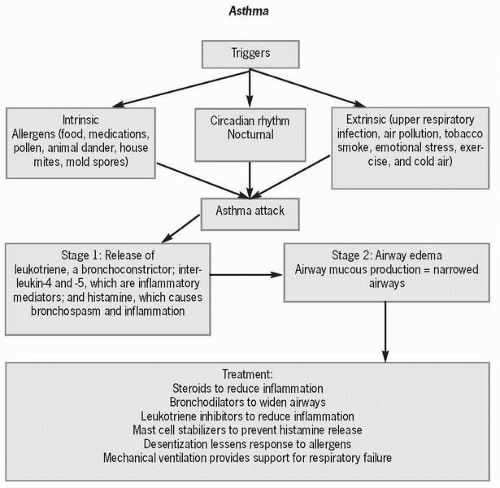Asthma
Chronic airflow limitation consists of three common respiratory diseases: asthma, chronic bronchitis, and emphysema. Asthma is the only one of the three chronic disease entities that produces intermittent, reversible airway obstruction. Asthma, which is characterized by acute airway inflammation, bronchoconstriction, bronchospasm, edema of the bronchioles, and increased production of mucus, is the most common chronic illness in children. Of the 15 million people in the United States with asthma, approximately 5% of adults and 8% of children are diagnosed.
TERMS
 Figure 25-1 Asthma. |
Approximately 470,000 people are admitted to the hospital each year because of asthma, and approximately 5,000 people die each year because of the disease. Children and African Americans have the highest hospital admission
rates for asthma; African-American teens and young adults (aged 15-24 years) have the highest death rates. The number of people diagnosed with asthma, the number of hospitalizations, and the number of deaths have all increased in the past 20 years. Characteristic signs and symptoms of asthma are chest tightness, cough, tachypnea, wheezing, anxiety, and dyspnea caused by airway narrowing. Unless treated promptly, asthma can lead to ineffective gas exchange and death. Status asthmaticus is a severe, prolonged asthma attack that does not respond to usual treatment and is life threatening.
rates for asthma; African-American teens and young adults (aged 15-24 years) have the highest death rates. The number of people diagnosed with asthma, the number of hospitalizations, and the number of deaths have all increased in the past 20 years. Characteristic signs and symptoms of asthma are chest tightness, cough, tachypnea, wheezing, anxiety, and dyspnea caused by airway narrowing. Unless treated promptly, asthma can lead to ineffective gas exchange and death. Status asthmaticus is a severe, prolonged asthma attack that does not respond to usual treatment and is life threatening.
 Asthma produces intermittent reversible airway obstruction.
Asthma produces intermittent reversible airway obstruction. Asthma is the most common chronic illness in children.
Asthma is the most common chronic illness in children. Children and blacks have the highest hospital admission rates for asthma; African-American teens and young adults (ages 15-24) have the highest death rates.
Children and blacks have the highest hospital admission rates for asthma; African-American teens and young adults (ages 15-24) have the highest death rates. Status asthmaticus does not respond to usual treatment.
Status asthmaticus does not respond to usual treatment.Wearing a face mask, which warms the air and retains airway humidity, is helpful in preventing exercise-induced asthma. Asthma caused by allergens can be managed by removing as much of the offending allergen as possible from the person’s environment. Air filters, absence of tobacco smoke, hardwood floors rather than carpets, and dusting daily are some of the measures used to control dust mites and other allergens. Desensitization treatments are also useful in controlling extrinsic asthma.
Asthma may be classified according to cause (e.g., extrinsic [allergic], intrinsic [idiopathic], nocturnal, exercise-induced, occupational, druginduced) or more precisely by severity (e.g., mild intermittent, mild persistent, moderate persistent, and severe persistent). People with mild intermittent asthma have symptoms less than twice a week with nighttime symptoms occurring less than twice a month, have few exacerbations of the disease, and have a peak expiratory flow greater than 80% of the predicted rate. Those with mild persistent asthma have symptoms more than twice a week but less than once a day, nighttime symptoms more than twice a month, and also have a peak expiratory flow greater than 80% of the predicted rate. Once the asthma symptoms occur daily, nighttime symptoms occur more than once a week, and the peak expiratory flow is more than 60% but less than 80%
of the expected rate, the person is said to have moderate persistent asthma. A person with severe persistent asthma has daily symptoms, must limit physical activity, has frequent nighttime symptoms, and has a peak expiratory flow less than 60% of the predicted rate.
of the expected rate, the person is said to have moderate persistent asthma. A person with severe persistent asthma has daily symptoms, must limit physical activity, has frequent nighttime symptoms, and has a peak expiratory flow less than 60% of the predicted rate.
Stay updated, free articles. Join our Telegram channel

Full access? Get Clinical Tree


